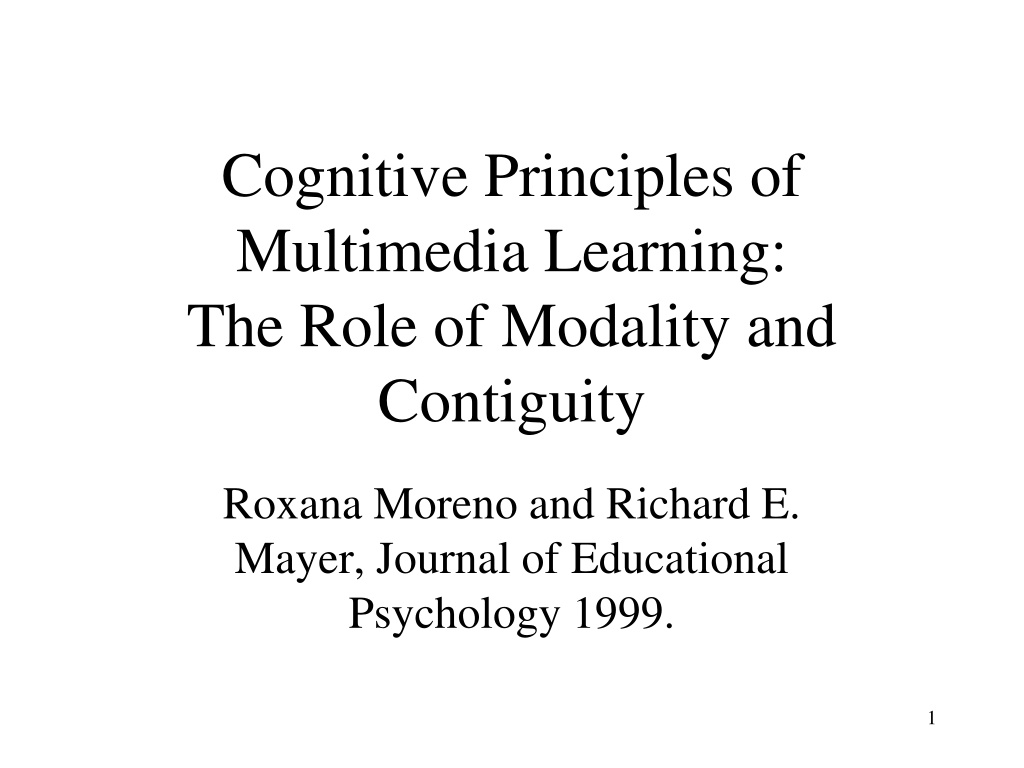
Principles of Multimedia Learning: Modality and Contiguity
Explore the Cognitive Principles of Multimedia Learning focusing on the Modality and Contiguity aspects based on a study by Roxana Moreno and Richard E. Mayer. Learn about the effectiveness of multimedia instruction in relation to how words and pictures are presented together, the importance of spatial and temporal contiguity, and the Modality Principle advocating for auditory narration over visual text in presentations. Dive into experiments highlighting the differences between spatial contiguity effects and modality effects using animations and proximity of visual text in learning scenarios.
Download Presentation

Please find below an Image/Link to download the presentation.
The content on the website is provided AS IS for your information and personal use only. It may not be sold, licensed, or shared on other websites without obtaining consent from the author. If you encounter any issues during the download, it is possible that the publisher has removed the file from their server.
You are allowed to download the files provided on this website for personal or commercial use, subject to the condition that they are used lawfully. All files are the property of their respective owners.
The content on the website is provided AS IS for your information and personal use only. It may not be sold, licensed, or shared on other websites without obtaining consent from the author.
E N D
Presentation Transcript
Cognitive Principles of Multimedia Learning: The Role of Modality and Contiguity Roxana Moreno and Richard E. Mayer, Journal of Educational Psychology 1999. 1
Contiguity Principle Effectiveness of multimedia instruction increases when words and pictures are presented contiguously 2
Contiguity Principle Effectiveness of multimedia instruction increases when words and pictures are presented contiguously Two effects: Spatial-contiguity effect Printed text and pictures physically integrated (we ve read about this one already) Temporal-contiguity effect Visual and spoken materials are temporally synchronized Example: operation of bike pump + narration 3
Modality Principle In multimedia presentations, words should be presented as auditory narration and not as visual on-screen text In short-term memory tasks, auditory presentation usually results in higher recall than does visual presentation (Penney 1989, Frick 1984) Attention better divided between two auditory or two visual channels (Wickens, 1984) 4
Modality Principle In multimedia presentations, words should be presented as auditory narration and not as visual on-screen text In short-term memory tasks, auditory presentation usually results in higher recall than does visual presentation (Penney 1989, Frick 1984) Attention better divided between two auditory or two visual channels (Wickens, 1984) (Question to Ken) What does this mean?? 5
Experiment One Experiment Two Goal: To distinguish between spatial contiguity effects and modality effects using animation How? By manipulation of proximity of visual text with animation 132 college low-experience students Results: Modality effect in which students learned better when verbal input presented as speech and not visual text Spatial-contiguity effect in which students learned better when visual and verbal materials presented physically close together Goal: To examine (more closely) the modality How? By manipulation of simultaneous or sequential presentation 127 college low-experience students Results: Modality effect in which students learned better when verbal input presented as speech and not visual text 6
Clarifying Cognitive Principles of Multimedia Design Calls for more precise term for split-attention effect Cannot distinguish between one of three cognitive effect types Spatial-contiguity effect Learning effects due to physical closeness of verbal and non- verbal visual materials Temporal-contiguity effect Learning effects due to synchronicity between verbal and non- verbal material Modality effects Learning effects due to different modalities to present verbal materials (speech versus text) 7
